Skip to content
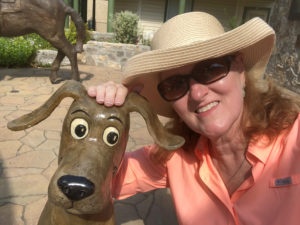
“Every ranch pickup ought to have at least one cow dog in the back,
barking at every passing truck.” – Hank the Cowdog, Ranch Life Book No. 1
I had to smile when I read that this Friday is National Dog Appreciation Day . . . because in my world, every day is dog appreciation day!
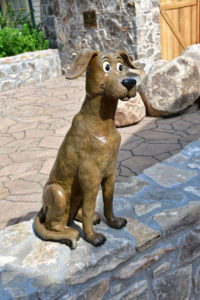 And as a Texan, what better dog to send some appreciation to than the star of the humorous mystery novel series Hank the Cow Dog.
And as a Texan, what better dog to send some appreciation to than the star of the humorous mystery novel series Hank the Cow Dog.
If you aren’t familiar with Hank, you’re in for a treat. This hysterical cow dog, or “Head of Ranch Security” as he prefers to be called, has a slew of doggone fun adventures among other characters that include Pete the Barn Cat, Slim Chance and Sally May – all created by Texas Literary Hall of Fame inductee John R. Erickson.
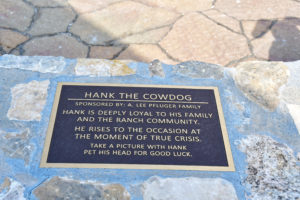
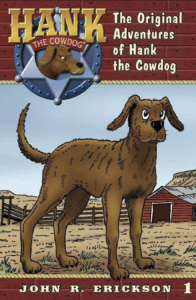 The books have sold over 9 million worldwide! Pretty darn good for an old dog! My daughter and I read dozens of them when she was little, and I’ve lost count of how many I’ve gifted to other kids.
The books have sold over 9 million worldwide! Pretty darn good for an old dog! My daughter and I read dozens of them when she was little, and I’ve lost count of how many I’ve gifted to other kids.
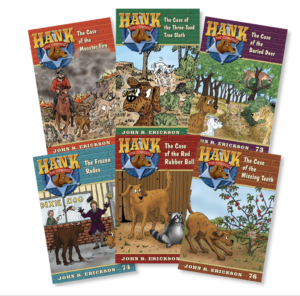 Do you have to be a kid or a Texan to get a kick out of Hank’s stories? Nope! People as far away as Taiwan are fans. But as long as you’re reading one, why not read it aloud to the nearest child? That will brighten both your days!
Do you have to be a kid or a Texan to get a kick out of Hank’s stories? Nope! People as far away as Taiwan are fans. But as long as you’re reading one, why not read it aloud to the nearest child? That will brighten both your days!
Erickson, whose hometown is Perryton, grew up in the Panhandle so his description of characters and written version of a Texas twang ring true. He got his literary start with San Angelo’s Livestock Weekly in the 1980s, mentored by another Texas writer named Elmer Kelton.
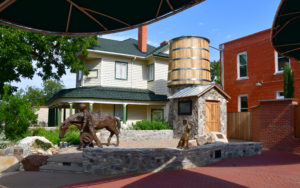 Being a long time fan of these books, if you think I made it a point to stop on a recent trip to San Angelo just to see an ode to Hank . . . well, you’d be right. A bronze statue of the Lone Star State’s beloved canine sits on a ledge in Heritage Park at the corner of West Twohig and Oakes Streets. Sculpted by San Antonio artist Raul Ruiz in 2018, he looks right at home with the other features of the pocket park displayed to honor the ranching and agricultural heritage of the state.
Being a long time fan of these books, if you think I made it a point to stop on a recent trip to San Angelo just to see an ode to Hank . . . well, you’d be right. A bronze statue of the Lone Star State’s beloved canine sits on a ledge in Heritage Park at the corner of West Twohig and Oakes Streets. Sculpted by San Antonio artist Raul Ruiz in 2018, he looks right at home with the other features of the pocket park displayed to honor the ranching and agricultural heritage of the state.
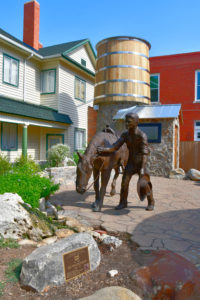 There’s a sculpture of a rancher and his trusty horse, native plants, a vintage cistern system and plenty of space to sit for a spell in the shade of a leaf-shaped overhang that provides an escape from the Texas sun. The park is open to the public daily from 8 a.m. to 8 p.m.
There’s a sculpture of a rancher and his trusty horse, native plants, a vintage cistern system and plenty of space to sit for a spell in the shade of a leaf-shaped overhang that provides an escape from the Texas sun. The park is open to the public daily from 8 a.m. to 8 p.m.
If you want to make a quick visit to one more spot in town honoring Lone Star literature, swing by the mural by Stylie Read of Elmer Stephen Kelton – Erickson’s mentor – author of over 50 western novels. It’s at 118 South Chadbourne Street.
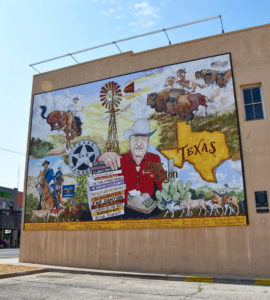
Now that school’s back in session, if your child is looking to add to their library list, they might just want to check out one of the over 70 stories about this scruffy, scrappy hound. The Texas tails…um, tales… are worth howling about.
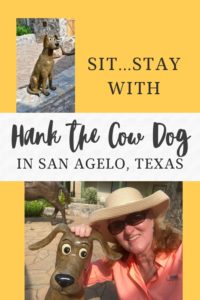
Biggest little town in the world, indeed!
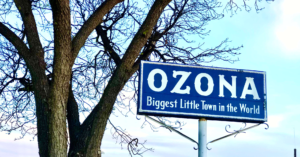
Ozona is the only community in Crockett County which is the size of Delaware. Yep, the only one! It’s about an hour southwest of San Angelo, 398 miles from Houston and 347 miles from El Paso. Which makes it a pretty good jumping-off point for a lot of directions.
But before you zoom through, consider stopping for some of the unique things that Ozona has to offer. We scheduled an extra night on our trip to Big Bend to give us time to wander around and explore . . .and to give the ol’ accelerator-foot a break.


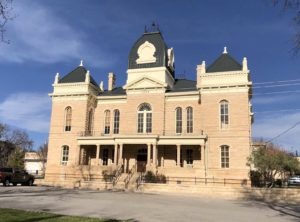
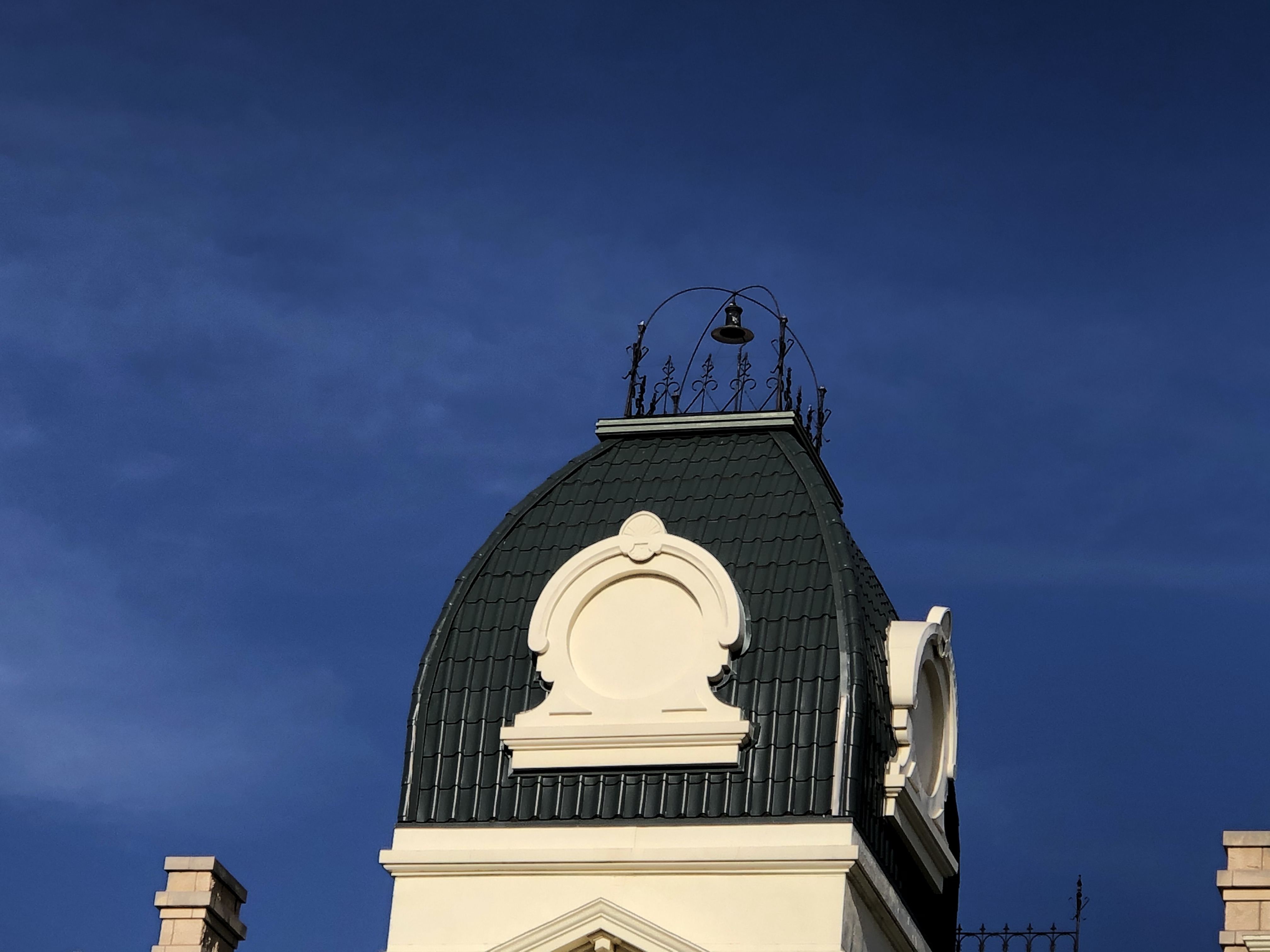



If you follow my blog or instagram account, you’ve probably figured out by now that I’m a sucker for historic courthouse buildings. I was happy to finally see this one in person.
The 1902 Second Empire courthouse of Crockett County – named after the legendary Davy Crockett – is the centerpiece of town. Designed by Oscar Ruffini, one of a pair of proliferate brother architects who kept busy populating Texas with their creations. Oscar also designed the Sutton County Courthouse, Tom Green County Courthouse and Ozona High School, and his brother Frederick Ernst designed the Concho County Courthouse, Bastrop County Courthouse, former Blanco County Courthouse (now restored) and the Millet Opera House in Austin.
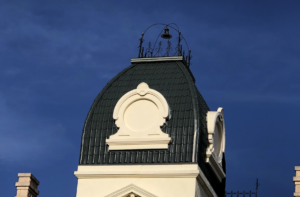 The courthouse was made from stone quarried on nearby property owned by the Crouch and Meyer families, and cost a whopping $30,000. In 1909 an arc light was added to the steeple to signal the sheriff (the Batman beacon comes to mind!) and guide travelers to town.
The courthouse was made from stone quarried on nearby property owned by the Crouch and Meyer families, and cost a whopping $30,000. In 1909 an arc light was added to the steeple to signal the sheriff (the Batman beacon comes to mind!) and guide travelers to town.
It was far more than a courthouse for Ozona and surrounding communities though, and served as a social center for cowboy dances, roundup celebrations, Christmas trees and box suppers (which reminds me of a particular scene from the musical Oklahoma!).
If the bull’s eye or “ox eye” circular moldings the mansard roof look like they’re missing something…they are! They were originally intended as a place for clock faces that were never installed. At one point in the past it bothered the locals enough to paint clocks in the features. When the courthouse was recently restored it was decided to leave them as is.
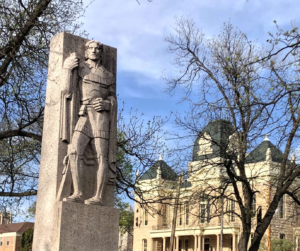 A memorial statue of Davy Crockett stands nearby on the square. Placed on its base in 1938, it was carved from two slabs of granite weighing nearly 20 tons (well, after all – he WAS a heavyweight of Texas history!), and is inscribed with Crockett’s motto, “Be sure you are right, then go ahead.” Still seems like sound advice.
A memorial statue of Davy Crockett stands nearby on the square. Placed on its base in 1938, it was carved from two slabs of granite weighing nearly 20 tons (well, after all – he WAS a heavyweight of Texas history!), and is inscribed with Crockett’s motto, “Be sure you are right, then go ahead.” Still seems like sound advice.
“The Tie that Binds” is an emotional bronze stands at the center of the square just a few strides away from Davy to remind visitors of the perseverance of their pioneer ancestors. At life-and-a-quarter size, it makes quite an impression close up!
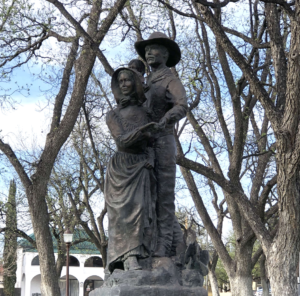
Just across the street is the former Hotel Ozona (not to be confused with the former Ozona Hotel . . . th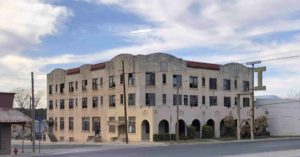 ey could have used a bit more imagination, evidently). The three-story mission style inn was built in 1927 to attract tourists along the Old Spanish Trail. See more of my photos of this abandoned beauty and find out more about the OST here.
ey could have used a bit more imagination, evidently). The three-story mission style inn was built in 1927 to attract tourists along the Old Spanish Trail. See more of my photos of this abandoned beauty and find out more about the OST here.
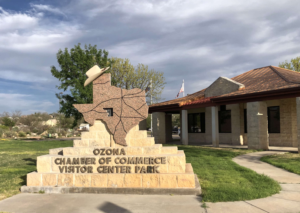
I really appreciate visitors centers that are more than a room filled with pamphlets, and the Ozona Chamber of Commerce and Visitor Center (505 15th Street) is definitely worth a stop (even if it’s just to see this cocky granite Texas sporting a Stetson). The building is bright and welcoming, and the staff are versed in numerous local and area attractions that might peak your interest.
Across the parking lot is the Crockett County Interpretive Trail (free to visit) showcasing native plants that can b e found within 100 miles of Ozona. The short trail (like a small park) has over 200 plants representing over 75 species, each identified b
e found within 100 miles of Ozona. The short trail (like a small park) has over 200 plants representing over 75 species, each identified b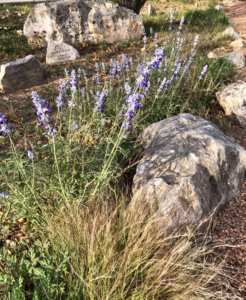 y an inscribed stone. We were lucky to stop by in spring when several of the plants were showing off their blooms, but the display would be fascinating year round. Botanists and gardening fans will get a kick out of this detailed brochure of the exhibit.
y an inscribed stone. We were lucky to stop by in spring when several of the plants were showing off their blooms, but the display would be fascinating year round. Botanists and gardening fans will get a kick out of this detailed brochure of the exhibit.
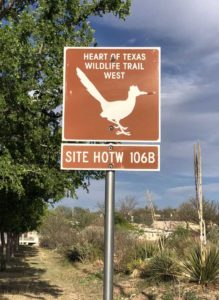
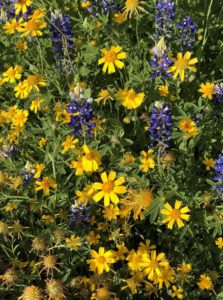
Off-roaders will definitely want to venture out to the Escondido Draw Recreational Area, a 3,500 acre, 110 mile trail for all-terrain vehicles, dirt bikes and 4-wheel drives.
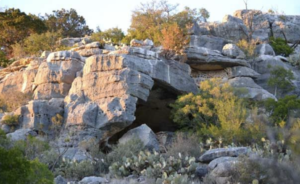
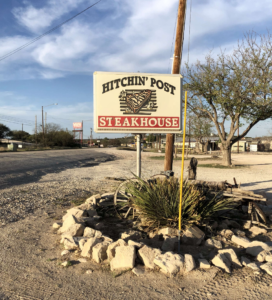 After driving all day and seeing a bit of town, we were ready to sit down for a good meal, the The Hitching Post Steakhouse (1301 Old Highway 290) came highly recommended. Actually, on some days of the week like we arrived on it’s pretty much the only game in town, but that’s just fine.
After driving all day and seeing a bit of town, we were ready to sit down for a good meal, the The Hitching Post Steakhouse (1301 Old Highway 290) came highly recommended. Actually, on some days of the week like we arrived on it’s pretty much the only game in town, but that’s just fine.
We were a bit confused when we pulled into the parking lot filled with at least two dozen fire trucks and resc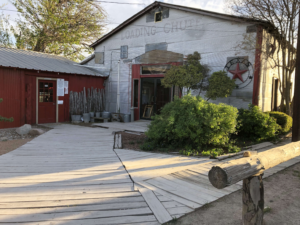 ue vehicles from all over Texas until we realized there was a firemen’s convention in town. But we definitely took that as a good sign, because let’s be honest – firemen know their food!
ue vehicles from all over Texas until we realized there was a firemen’s convention in town. But we definitely took that as a good sign, because let’s be honest – firemen know their food!
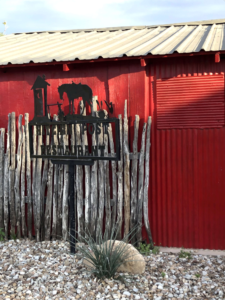 The western theme, come-as-you-are restaurant probably hasn’t been redecorated much in the last few decades, which the faded photos of Old West Outlaws and cowhide on the wall, heavy wooden club chairs and indoor/outdoor carpeting will attest to – but you won’t care a bit once your food arrives. If you’re looking for good food at reasonable prices, The Hitching Post fits the bill.
The western theme, come-as-you-are restaurant probably hasn’t been redecorated much in the last few decades, which the faded photos of Old West Outlaws and cowhide on the wall, heavy wooden club chairs and indoor/outdoor carpeting will attest to – but you won’t care a bit once your food arrives. If you’re looking for good food at reasonable prices, The Hitching Post fits the bill.
A smoking room on one side has pool tables and the bar, and the other side of the building has non-smoking seating. An outdoor patio is also a good option for dining on fair weather days.
Thirsty for something stronger than tea? Be forewarned that the restaurant charges a $5 club fee to “join” to order alcohol.
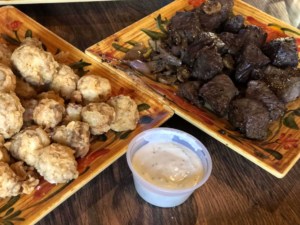 Since we hadn’t worked up big appetites we decided to split a couple of appetizers, and settled on marinated cube steaks and 1/2 order of fried mushrooms. The portions were generous and deliciously seasoned. Thank heaven the waitress suggested we choose a half order of mushrooms, since a full order would have fed half the firemen in the room.
Since we hadn’t worked up big appetites we decided to split a couple of appetizers, and settled on marinated cube steaks and 1/2 order of fried mushrooms. The portions were generous and deliciously seasoned. Thank heaven the waitress suggested we choose a half order of mushrooms, since a full order would have fed half the firemen in the room.
I’ll definitely go back to try the chicken fried steak next time I’m in town. The fact that they’re open until 11 p.m. makes it easy if one of your day trips from Ozona runs a bit longer than expected.
If you have a bit more time during your visit to Ozona, you might want to explore:
-
Crockett County Museum
-
Fort Lancaster State Historic Site in Sheffield
-
Caverns of Sonora (34 miles)
Accommodations: We enjoyed our stay at the Holiday Inn Express Hotels & Suites. The staff was friendly and the rooms were lovely and clean. Just be aware that if you’re booking because you find a great rate, there might be unexpected charged added at checkout. Our $111 rate (which was one of the selling points that helped us decide to make Ozona a stop)— ended up costing about $165 which is a heck of a difference and more expensive than any of the other stays on our 10-day trip!
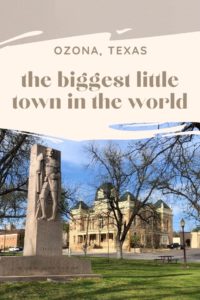

_ . _.._ ._ …
If it looks like I just accidently hit some random keys while beginning to type this, morse code might not be in your wheelhouse. The mysterious string of dots and dashes spells out the name of a place I love: Texas!
On 100 block of North Washington street in Marshall, facing their enormous courthouse, this life size bronze statue reminds passersby that the town holds a unique place in communication history. It sits on the spot where the first telegraph office in the state opened in February 14, 1854. Long-distance communication w-a-y before cellphones and emails made it something that we take for granted.
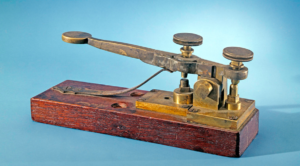
The Texas and Red River Company opened its Marshall office and strung wires all the way to Shreveport, which in turn had wires to New Orleans. By 1854 another line connected the town to Houston via other lines. That opened up a lot of business opportunities for the railroad town.
By 1870 there were about 1,500 miles of telegraph wire across the Lone Star State. Instead of riders on horseback an stagecoach carrying 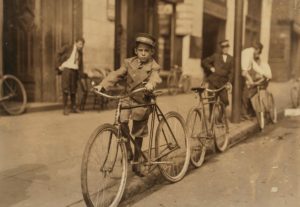 handwritten messages for days, a series of sounds could be translated into words and handed to messenger boys as young as 10 years old who would deliver the messages on their bikes within minutes.
handwritten messages for days, a series of sounds could be translated into words and handed to messenger boys as young as 10 years old who would deliver the messages on their bikes within minutes.
Now here’s the part that’ll leave you scratching your head…
In 1838, Samuel F. B. Morse (the inventor of the telegraph) wrote a letter to Memucan Hunt. Hunt was a friend of Morse’s who just happened to be the Republic of Texas minister to the United States who had told the inventor countless stories about Texas. He had explained that although the republic had lots of land and heart…it was a bit short on revenue.
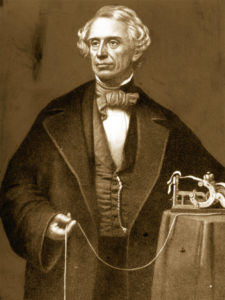
In the letter, Morse offered the answer to that problem by GIVING the rights to his incredible invention to Texas. Um, WHAT?!
 Somehow the letter, which had been forwarded to officials of the republic, ended up filed away, gathering dust.
Somehow the letter, which had been forwarded to officials of the republic, ended up filed away, gathering dust.
Y-e-a-r-s later in 1860, Morse wrote a follow up letter to Texas Governor Sam Houston.
“In the year 1838 I made an offer of gift of my invention of the Electro magnetic Telegraph to Texas … Although the offer was made more than twenty years ago, Texas … has never directly or impliedly accepted the offer. I am induced, therefore, to believe that in its condition as a gift it was of no value to the State … I, therefore, now respectfully withdraw the offer made then.”
Wow, talk about an opportunity falling through the cracks! Imagine how much money Texas could have made as the owner of that patent. Sigh…
So while this beautiful bronze statue reminds us of an immense accomplishment…there is definitely a “oops” factor attached!
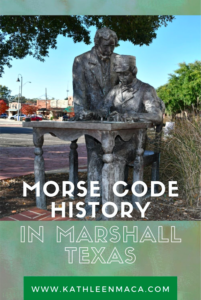
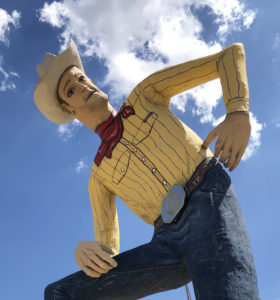
If you think you have trouble finding clothes to fit, just be thankful you aren’t a 47-foot tall cowboy!
You’ve heard the saying that everything is “bigger in Texas,”
“Tex Randall,” the 47-foot tall, seven ton statue in Canyon, Texas was designed and built in 1959 by Harry Wheeler (1914-1997) to draw Route 66 tourists to his Corral Curio Shop and six-room motel. Wheeler, an industrial arts teacher, spent ten months forming the lanky cowboy out of six-inch wire mesh, rebar and concrete.
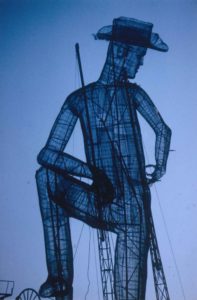
And here’s the really amazing part…
Though his clothes are painted on today, they weren’t originally! Tex’s first Western-style shirt was made by Amarillo awning, using an impressive 1,440 square feet of material. Wheeler sewed it closed in back with sailboat thread, and created sheet aluminum snap buttons and a belt buckle the size of a television screen.
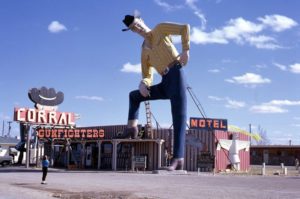
Levi Strauss’ nearby plant made real jeans for him that had to be sewn onto the statue on site. The pants were lifted into place with a crane, and Wheeler stood below, adjusting the “fit” and sewing them together. How’s that for a tall tailor order?
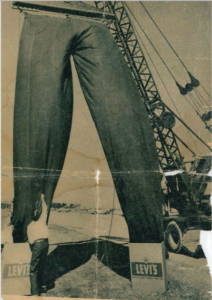
Tex’s boots and features were painted onto the surface of the statue, and he was crowned with a Stetson style hat.
As far as relics from the Route 66 heyday, this tall Texan definitely fits the bill. He became one of the roadside attractions that people would drive miles to see and photograph.
Due to reconstruction of the highway, business at his shop and motel declined. That and personal business caused Wheeler sold the property in 1963. He refused offers to buy Tex that came in from Las Vegas and businesses along Route 66, preferring that his labor of love remain in Canyon.
The following decades of Panhandle winds and weather shredded the figure’s fabric clothes; a semi-truck crashed into his left boot and the original cigarette was shot out of his right hand. The elements sandblasted away large portions of his skin, and his concrete fingers began to crumble.
An Amarillo area businessman purchased Tex with the intention of moving him to his business, but gave up when he learned it would cost $50,000.
In 1987, local community leaders began a “Save the Cowboy” campaign and raised the money to restore Tex. The no longer socially acceptable ci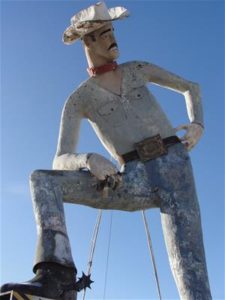 garette in his hand was replaced with a spur, new clothes were painted on to replace the lost fabric set, and he was given an 80s-style moustache.
garette in his hand was replaced with a spur, new clothes were painted on to replace the lost fabric set, and he was given an 80s-style moustache.
By 2010, it became apparent that a more thorough restoration of the statue was needed, and the Canyon community and Canyon Main Street volunteers rallied to save the icon.
The Texas Department of Transportation stepped in to help and set aside almost $300,000 to turn the land around Tex’s boots into a park.
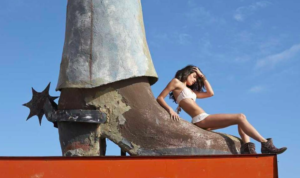 Tex’s cameo appearance in the 2015 Sports Illustrated swimsuit issue provided the exposure to increase interest in the project. After six years of fundraising and work, the project was completed in December 2016, and Tex received his own Texas State Historical Marker in 2017.
Tex’s cameo appearance in the 2015 Sports Illustrated swimsuit issue provided the exposure to increase interest in the project. After six years of fundraising and work, the project was completed in December 2016, and Tex received his own Texas State Historical Marker in 2017.
Tex’s appearance now more closely resembles his original 1950s appearance, and much to Wheeler’s daughter Judy’s delight the moustache is gone.
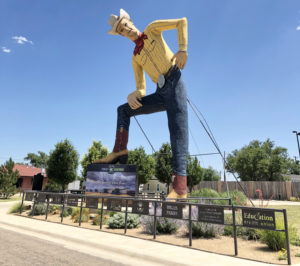
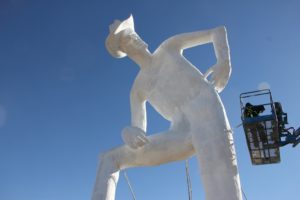
Tex isn’t the state’s “biggest Texan” any more … he is outsized by the Sam Houston statue in Huntsville, but this lanky character holds a special place in generations of Panhandle residents’ hearts and tourists’ photos.
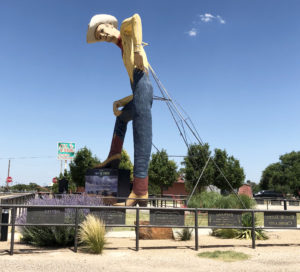
If you plan to go by and say “Howdy” to Tex, swing into 1400 North 3rdAvenue, Canyon, Texas.
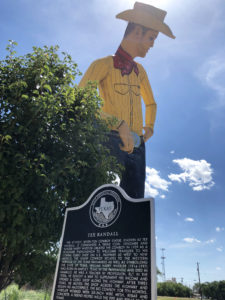

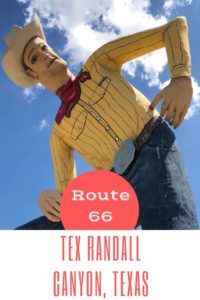
 And as a Texan, what better dog to send some appreciation to than the star of the humorous mystery novel series Hank the Cow Dog.
And as a Texan, what better dog to send some appreciation to than the star of the humorous mystery novel series Hank the Cow Dog.
 The books have sold over 9 million worldwide! Pretty darn good for an old dog! My daughter and I read dozens of them when she was little, and I’ve lost count of how many I’ve gifted to other kids.
The books have sold over 9 million worldwide! Pretty darn good for an old dog! My daughter and I read dozens of them when she was little, and I’ve lost count of how many I’ve gifted to other kids. Do you have to be a kid or a Texan to get a kick out of Hank’s stories? Nope! People as far away as Taiwan are fans. But as long as you’re reading one, why not read it aloud to the nearest child? That will brighten both your days!
Do you have to be a kid or a Texan to get a kick out of Hank’s stories? Nope! People as far away as Taiwan are fans. But as long as you’re reading one, why not read it aloud to the nearest child? That will brighten both your days! Being a long time fan of these books, if you think I made it a point to stop on a recent trip to San Angelo just to see an ode to Hank . . . well, you’d be right. A bronze statue of the Lone Star State’s beloved canine sits on a ledge in Heritage Park at the corner of West Twohig and Oakes Streets. Sculpted by San Antonio artist Raul Ruiz in 2018, he looks right at home with the other features of the pocket park displayed to honor the ranching and agricultural heritage of the state.
Being a long time fan of these books, if you think I made it a point to stop on a recent trip to San Angelo just to see an ode to Hank . . . well, you’d be right. A bronze statue of the Lone Star State’s beloved canine sits on a ledge in Heritage Park at the corner of West Twohig and Oakes Streets. Sculpted by San Antonio artist Raul Ruiz in 2018, he looks right at home with the other features of the pocket park displayed to honor the ranching and agricultural heritage of the state. There’s a sculpture of a rancher and his trusty horse, native plants, a vintage cistern system and plenty of space to sit for a spell in the shade of a leaf-shaped overhang that provides an escape from the Texas sun. The park is open to the public daily from 8 a.m. to 8 p.m.
There’s a sculpture of a rancher and his trusty horse, native plants, a vintage cistern system and plenty of space to sit for a spell in the shade of a leaf-shaped overhang that provides an escape from the Texas sun. The park is open to the public daily from 8 a.m. to 8 p.m.

 The courthouse was made from stone quarried on nearby property owned by the Crouch and Meyer families, and cost a whopping $30,000. In 1909 an arc light was added to the steeple to signal the sheriff (the Batman beacon comes to mind!) and guide travelers to town.
The courthouse was made from stone quarried on nearby property owned by the Crouch and Meyer families, and cost a whopping $30,000. In 1909 an arc light was added to the steeple to signal the sheriff (the Batman beacon comes to mind!) and guide travelers to town. A memorial statue of Davy Crockett stands nearby on the square. Placed on its base in 1938, it was carved from two slabs of granite weighing nearly 20 tons (well, after all – he WAS a heavyweight of Texas history!), and is inscribed with Crockett’s motto, “Be sure you are right, then go ahead.” Still seems like sound advice.
A memorial statue of Davy Crockett stands nearby on the square. Placed on its base in 1938, it was carved from two slabs of granite weighing nearly 20 tons (well, after all – he WAS a heavyweight of Texas history!), and is inscribed with Crockett’s motto, “Be sure you are right, then go ahead.” Still seems like sound advice.
 ey could have used a bit more imagination, evidently). The three-story mission style inn was built in 1927 to attract tourists along the Old Spanish Trail. See more of my photos of this abandoned beauty and find out more about the OST here.
ey could have used a bit more imagination, evidently). The three-story mission style inn was built in 1927 to attract tourists along the Old Spanish Trail. See more of my photos of this abandoned beauty and find out more about the OST here.
 e found within 100 miles of Ozona. The short trail (like a small park) has over 200 plants representing over 75 species, each identified b
e found within 100 miles of Ozona. The short trail (like a small park) has over 200 plants representing over 75 species, each identified b y an inscribed stone. We were lucky to stop by in spring when several of the plants were showing off their blooms, but the display would be fascinating year round. Botanists and gardening fans will get a kick out of this detailed brochure of the exhibit.
y an inscribed stone. We were lucky to stop by in spring when several of the plants were showing off their blooms, but the display would be fascinating year round. Botanists and gardening fans will get a kick out of this detailed brochure of the exhibit.


 After driving all day and seeing a bit of town, we were ready to sit down for a good meal, the The Hitching Post Steakhouse (1301 Old Highway 290) came highly recommended. Actually, on some days of the week like we arrived on it’s pretty much the only game in town, but that’s just fine.
After driving all day and seeing a bit of town, we were ready to sit down for a good meal, the The Hitching Post Steakhouse (1301 Old Highway 290) came highly recommended. Actually, on some days of the week like we arrived on it’s pretty much the only game in town, but that’s just fine. ue vehicles from all over Texas until we realized there was a firemen’s convention in town. But we definitely took that as a good sign, because let’s be honest – firemen know their food!
ue vehicles from all over Texas until we realized there was a firemen’s convention in town. But we definitely took that as a good sign, because let’s be honest – firemen know their food! The western theme, come-as-you-are restaurant probably hasn’t been redecorated much in the last few decades, which the faded photos of Old West Outlaws and cowhide on the wall, heavy wooden club chairs and indoor/outdoor carpeting will attest to – but you won’t care a bit once your food arrives. If you’re looking for good food at reasonable prices, The Hitching Post fits the bill.
The western theme, come-as-you-are restaurant probably hasn’t been redecorated much in the last few decades, which the faded photos of Old West Outlaws and cowhide on the wall, heavy wooden club chairs and indoor/outdoor carpeting will attest to – but you won’t care a bit once your food arrives. If you’re looking for good food at reasonable prices, The Hitching Post fits the bill. Since we hadn’t worked up big appetites we decided to split a couple of appetizers, and settled on marinated cube steaks and 1/2 order of fried mushrooms. The portions were generous and deliciously seasoned. Thank heaven the waitress suggested we choose a half order of mushrooms, since a full order would have fed half the firemen in the room.
Since we hadn’t worked up big appetites we decided to split a couple of appetizers, and settled on marinated cube steaks and 1/2 order of fried mushrooms. The portions were generous and deliciously seasoned. Thank heaven the waitress suggested we choose a half order of mushrooms, since a full order would have fed half the firemen in the room.
 handwritten messages for days, a series of sounds could be translated into words and handed to messenger boys as young as 10 years old who would deliver the messages on their bikes within minutes.
handwritten messages for days, a series of sounds could be translated into words and handed to messenger boys as young as 10 years old who would deliver the messages on their bikes within minutes. Somehow the letter, which had been forwarded to officials of the republic, ended up filed away, gathering dust.
Somehow the letter, which had been forwarded to officials of the republic, ended up filed away, gathering dust.



 garette in his hand was replaced with a spur, new clothes were painted on to replace the lost fabric set, and he was given an 80s-style moustache.
garette in his hand was replaced with a spur, new clothes were painted on to replace the lost fabric set, and he was given an 80s-style moustache. Tex’s cameo appearance in the 2015 Sports Illustrated swimsuit issue provided the exposure to increase interest in the project. After six years of fundraising and work, the project was completed in December 2016, and Tex received his own Texas State Historical Marker in 2017.
Tex’s cameo appearance in the 2015 Sports Illustrated swimsuit issue provided the exposure to increase interest in the project. After six years of fundraising and work, the project was completed in December 2016, and Tex received his own Texas State Historical Marker in 2017.

